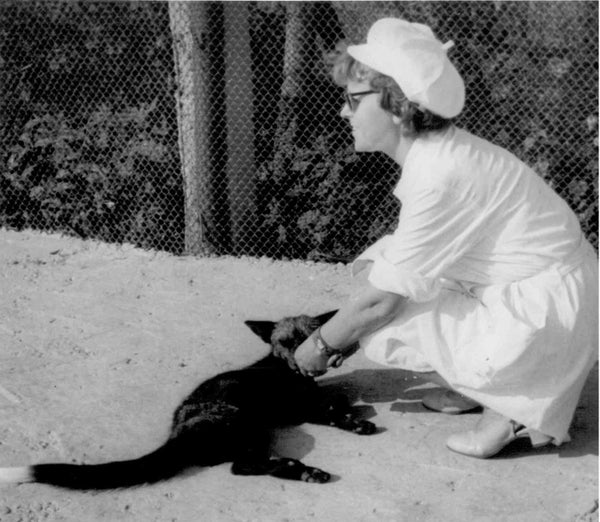October 24, 2024
4 min read
The Daring Russian Geneticist Whose Experiments on Silver Foxes Explained Domestication Has Died
Lyudmila Trut devoted her life to studying the process of domestication by selectively breeding friendly foxes

Lyudmila Trut, the geneticist who led the decades-long experiment that created hundreds of ultralovable domesticated foxes on a farm in Novosibirsk, Russia, died peacefully in her sleep on October 9, just shy of her 91st birthday. Over the past six decades, the work that Trut and her colleagues have done on the silver fox, a variant of the red fox, has become the gold standard for understanding the process of domestication.
When 25-year-old Trut graduated Moscow State University in 1958, she took a huge risk. Geneticist Dmitri Belyaev had asked her to head an experiment using foxes, which are closely related to dogs, to better understand how the process of domestication unfolded and what evolutionary forces were in play. The risk lay not only in the fact that an experiment on domestication in a large mammal could take decades to run but because the megalomaniacal Soviet agronomist Trofim Lysenko, whose denouncement of Mendelian—what he called “Western”—genetics exacerbated famines that killed millions, still wielded enough power in the Soviet Union to have people jailed for doing the genetic research that rested at the heart of the silver fox domestication experiment. Trut saw the scientific potential and accepted the risks. For the next 66 years, she devoted her life to that experiment, adopting a motto from Antoine de Saint-Exupéry’s The Little Prince: “You become responsible forever for what you have tamed.”
The radical idea that Belyaev (who died in 1985) and Trut set out to test was that domestication syndrome—the phenomenon in which domesticated species share a suite of characteristics, including floppy ears, a curly tail, juvenilized facial and body features and mottled fur—was the result of our ancestors consistently breeding the calmest, friendliest animals during the early stages of domestication. They further hypothesized that all of the traits involved in domestication syndrome were linked to genes associated with calmness and a tendency to display friendly behavior toward humans. Initially Trut tested the foxes by measuring how they responded as she approached their cage, opened its door and then placed her hand—which was protected by a very thick glove that went up to her elbow—into it. The most placid foxes were selected to breed the next generation. Over time, the details of that protocol have changed, but the basic approach remains the same. Ultimately the results of the experiments supported Trut and Belyaev’s ideas, revolutionizing scientific understanding of domestication.
On supporting science journalism
If you’re enjoying this article, consider supporting our award-winning journalism by subscribing. By purchasing a subscription you are helping to ensure the future of impactful stories about the discoveries and ideas shaping our world today.
We visited Novosibirsk in the winter of 2012 and again during the winter of 2014 to do work on a book about the fox experiment. Trut, ever the scientist, was certainly in full gear during those visits, eager to give us every detail of what had happened over the course of the experiment. But what really struck us was what a kind and caring person she was. On our first visit, when we landed at Tolmachevo Airport on an absolutely frigid Siberian winter night, we knew a driver would be there to meet us and take us to our hotel. What we didn’t know was that 78-year-old Trut would be there as well, smiling and welcoming her American guests to her beloved home country.
A devoted host who made us feel right at home in a faraway land, Trut greeted us each morning with a plate of local sweets and an offering of “coffee or tea?” which soon morphed into “coffee or tea or hot chocolate?” when she intuited that one of us (Aaron Dugatkin), who was a teenager at the time, might appreciate such things. A few days later, amid this constant flow of refreshments, Trut told a moving story about Pushinka, a special fox she had lived with for a period of months during the early 1970s in a tiny house on the experimental farm. The idea was to see whether the experiment had already produced foxes so calm and friendly that people could live with them, as we do with dogs. During their time together, Trut and Pushinka formed a remarkable bond. Pushinka would sneak into Trut’s bedroom late at night and cozy up next to her in bed. And when Pushinka gave birth, she even took one of the newborns and placed it into Trut’s lap. Trut would take Pushinka and her pups on walks, play with them and call them by name. Within just 15 generations of selective breeding, the experiment had yielded foxes that could live with people.
By the time of our visit, that house had fallen into an awful state of disrepair, but despite the fact there was more than two feet of snow on the ground, Trut—who stood barely five feet tall herself—insisted on leading us there to give us a tour through the frigid ruins of the building. It was the least she could do, both for her guests and for her dear friend Pushinka.
Humble by nature, Trut tended to answer questions about her role in the fox project by paying tribute to her mentor, Belyaev. But Trut was the one who devised the specific experiments and who, day after day—for more than 23,000 days—led the work. That effort required more than just a scientific skill set. In the 1990s, as Russia’s government underwent massive changes following the fall of the Soviet Union, funding for science fell to the wayside, and the fox experiment was at risk of ending. Trut would not allow that. Some days, she and her team stood on the side of a road near the experimental farm and waved down passing cars, soliciting donations to keep her beloved foxes fed and healthy and the experiment going. She also reached out and published an article in American Scientist that not only detailed the pathbreaking work they had already done but also explained why the experiment must continue. That article generated enough publicity (and funding) to save the day and keep the experiment alive.
Toward the end of our last visit, we asked Trut about her hopes for the future. “One day I will be gone,” she replied, “but I want my foxes to live forever.”
This is an opinion and analysis article, and the views expressed by the author or authors are not necessarily those of Scientific American.

